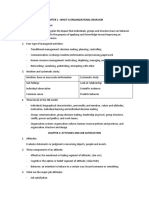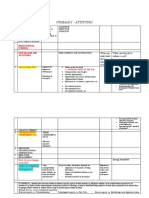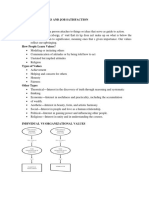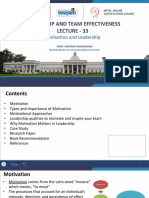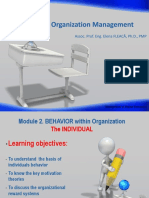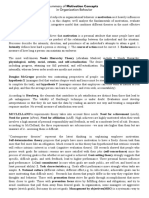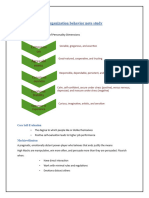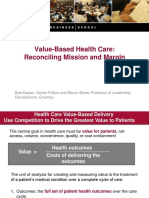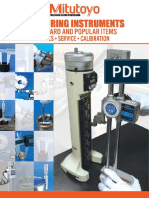Attitudes, difference between attitude, personality, and behavior, two kinds of job
attitude, job satisfaction and org commitment, and outcomes they predict, how job
satisfaction is measured.
Attitude: evaluative statement, either favorable or unfavorable,
about objects, people or events. They reflect how we feel about
things
Cognitive component
Affective component
Behavior component
Cognitive dissonance
People seek consistency between attitudes and behaviors, to
avoid dissonance.
Will alter attitude, change behavior, or develop rationalization for
discrepancy.
Attitude tend to predict behavior
Moderating variable: importance of attitude, its correspondence
to behavior, its accessibility, presence of social pressure,
whether people have direct experience with the attitude.
Two major job attitudes
- Job satisfaction
Single global rating is better measurement than summation of
job facets
-
Organizational commitment
Affective commitment (emotional)
Continuance commitment (economical)
Normative commitment (ethical)
Job satisfaction
Positive correlation to job performance
Positive correlation to customer satisfaction
Weak positive correlation to absenteeism
Positive correlation to low turn over
Emotions and Moods
�Emotions are more fleeting than moods.
Structure of Mood
Emotions are critical to rational thinking.
Emotional labor: express org desired emotions
Emotional dissonance surface acting, deep acting
Personality - big Five, what is each related to, how is personality measured, where is
personality most useful.
Personality: sum total of ways in which an individual reacts to and
interacts with others.
Measure personality: through self-report surveys (respondent
may lie to influence hiring decision, may be in bad mood)
Personality determinants: more heredity over environment
Big Five
�Conscientiousness is the trait most consistently related to job
performance
Emotional stability is the trait most strongly related to life, job
satisfaction
Openness is related to creativity
�Personality-job fit theory
Holland presents 6 personality types and proposed that satisfaction
and propensity to leave a position depend on how well is the
personality-job fit
Values - instrumental and terminal values, why do we care about values, where do
values come in play
Value: Basic convictions that a mode of conduct is preferable to an
opposite
Value lay the foundation for our understanding of peoples attitudes
and motivation, and influence our perception
Rokeach Value Survey consists two set of values P51
Terminal value: desirable end states, goals a person would like to
achieve
Instrumental value: preferable modes of behavior of achieving
terminal values
Person-Organization Fit
People are attracted to and selected by org that match their values,
and leave org that are not compatible with their personalities.
Motivation - theories of motivation, goal setting theory, expectancy theory, org
justice
Motivation: the processes that accounts for individuals intensity, direction, and
persistence of effort toward attaining a goal.
Three key elements: intensity, direction, and persistence
Theories of motivation
- Maslows Hierarchy of Needs Theory
Theory X and Theory Y
X (employee dislike work), Y (employee seek responsibility)
Two-Factor Theory
Satisfier factor (achievements, recognition, growth, )
Dissatisfier factor (supervision, pay, company policy, working
condition, etc) are hygiene factors, that when adequate people
will not be dissatisfied. That doesnt mean they will be satisfied
either.
Self-Determination Theory
People prefer to feel that they have control over their actions.
Obligation undermines motivation. Extrinsic rewards reduce
intrinsic interest
Goal Setting Theory
Specific goals increase performance
Difficult goals when accepted result in higher performance
Do your best is too vague
Measurement by Objectives: set goals that are tangible,
verifiable, and measurable. Org objectives-divisionaldepartmental-individual objectives.
Self-Efficacy Theory
Self-efficacy: an individuals belief that she is capable, higher
self-efficacy higher performance
To increase self-efficacy: enactive mastery, vicarious modeling,
verbal persuasion, arousal
Equity Theory / Organizational Justice
Employees perceive ratio of job input and outcome, and compare
with peers, a state of equity exists, is it fair.
Self-inside, self-outside, other-inside, other-outside
comparison
If perceive inequity, may change input, change output,
distort perception, leave field, etc.
Expectancy Theory (the most widely accepted explanation of
motivation)
The strength of tendency to act in a certain way depends on the
strength of our expectation of a given outcome and its
attractiveness.
Job characteristic model, how this model make work more interesting, five facet, the
most important facet, motivation application - differential pay structure, which is
more effective,
Job characteristic model: can describe job in five core dimensions
�Redesign Job
Job rotation
Job enrichment
Flextime
Telecommuting
Variable-Pay Program
Bases a portion of pay on individual/organizational performance
Piece-rate pay: paying fixed sum for each unit of production
Merit-based pay: paying based on performance appraisal rating;
only as valid as performance rating
Bonuses: higher incentive effect than merit-based pay
Skill-based pay
Profit-sharing plan: greater feeling of psychological ownership;
increase profit
Gainsharing: improves group performance
Employee stock ownership plan: increase employee satisfaction,
unclear impact on performance; reduce unethical behavior of top
management
Power and politics - where does power come from, influence, difference between
tactics, which tactics are more important
Power: a capacity that A has to influence the behavior of B
Power comes from dependency
Bases of power
- Formal power: based on individuals position in organization
Coercive power: based on fear of negative results
Reward power
Legitimate power: based on structural position in
organization
- Personal power
Expert power
Referent power: based on admiration or desire to be that
person
�Personal power is more effective; coerce power may backfire
Power tactics
Rational persuasion, inspirational appeal, and consultation tend to
be the most effective.
Pressure tends to be the least effective
Organizational politics: activities that are not required as formal
role, but attempt to influence the distribution of advantages.
May threaten employees: decrease satisfaction, increase anxiety,
increase turnover, reduce performance
�Impression management
Enhancement: Claiming done more valuable than others
would think
Exemplification: Doing more than needed to show dedication
Team effectiveness model - decision making (on class slides), creativity, barriers to
group decision making, techniques to overcome barriers,
Work team: work group that generates positive synergy through coordinated effort.
Team effectiveness model
High ability team do not perform simple task as well.
Demographic diversity is unrelated to team performance overall.
Diversity in function and expertise are positively related to team performance.
Turnover will be greater among those with dissimilar experience.
Size of team 7-9 ideal
Mental models: knowledge and beliefs of how work gets done.
Relationship conflicts bad, task conflicts not bad
Decision Making
�Programmed versus non-programmed decisions
Decision criteria How important?
Errors in decision making (heuristics, overconfidence, anchoring effects etc.)
Rationality versus Bounded rationality
Intuition
Group decision making Advantages & disadvantages
Advantages
1. Completeness
2. Diversity
3. Acceptance and commitment
4. Legit
Disadvantages
1. Time
2. Dominant voices
3. Groupthink
4. Accountability
Techniques for group decision making
Brainstorming
Nominal group (A group process involving problem identification, solution
generation, and decision making. First, every member of the group gives their
view of the solution, with a short explanation. Then, duplicate solutions are
eliminated, and the members proceed to rank the solutions, 1st, 2nd, and so on.)
Devils advocacy
Dialectical inquiry
Delphi technique
Creativity and decisions!
Leadership - trait, behavior theory, transformational leadership, exchange theory
Leadership: ability to influence a group towards a vision or goals
Trait Theories
Extraversion strongly related to leader emergence than to leader
effectiveness
Conscientious and openness positively related to leadership
Too assertive leads to less effective leadership
Traits can predict leadership emergence better than effectiveness
Behavior Theories locate ways effective leaders behave
Initiating structure: organize work, relationship, goals (production-oriented
leader)
Consideration: mutual trust respect for employees ideas/feelings (employeeoriented leader)
People could be trained to be leaders.
Contingency Theories
Condition a Style X suitable; condition a Style Y suitable
Fiedler Model: effective group performance depends on the proper match between
leaders style and the degree of leaders situation control.
Relationship oriented leader: favorable term on least preferred coworker
questionnaire
Task oriented leader: unfavorable term on LPC
�Situation dimensions
Leader-member relations: trust/no trust?
Task structure: structured/unstructured?
Position power: strong?
Situation: high and low control task oriented leader better
Situation: moderate control relationship oriented leader better
Leader-Member Exchange Theory
Charismatic leadership
Followers make attributions of heroic or extraordinary leadership abilities when they
observe certain behaviors.
Charismatic leaders are born, and can be made.
Effectiveness depends on situation ideological task or stressful uncertain
environment.
��Transformational leadership better on bottom line in small private firms than
complicated organizations.
Accuracy for performance evaluation will be tested in quiz and also
final exam.
Performance assessment Accuracy
-validity
-reliability
-lack of deficiency
Managerial implications:
Make jobs interesting
Measure performance accurately
Tie performance to rewards that are valued
Clearly define performance objectives
Fairness
�Job satisfaction 5 facets:
- Pay
- Work itself (the most important facet?)
- Promotion opportunities
- Supervision
- Co-workers
Core
-
self-evaluation CSE
Self esteem
Locus of control
Self efficacy
Emotional stability
Personality
- Machiavellianism
- Narcissism
- Self-monitoring
- Risk propensity
- Type A
- Proactive personality
Values
Instrumental and Terminal
Value congruence
Values driven behavior match up between person and
organization
Team composition
1. Member roles: Team task based, Team Building, individualistic
2. Ability: Cognitive ability helps when tasks are complex and
ambiguous
3. Personality: Conscientiousness & openness (the higher the
better), Agreeableness & Extraversion (Moderate).
4. Diversity: Helps creativity, hinders communication, Time matters
�in helping people figure out surface level and deep level
diversity.
5. Size: the 2-pizza rule
Cases and Readings
job crafting can be a powerful tool for reenergizing and reimagining
your work life. It involves redefining your job to incorporate your
motives, strengths, and passions. The exercise prompts you to
visualize the job, map its elements, and reorganize them to better suit
you.
Your job comprises a set of building blocks that you can reconfigure to
create more engaging and fulfilling experiences at work.









